Home / Past Newsletters / August 2012
August 2012
In this issue: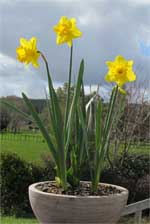
What's new...
New moulds:
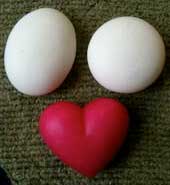 New moulds that have arrived since our last newsletter have something for everyone. My favourite is the three-cavity mould with a heart, a round and an oval - it's so difficult to find really nice basic shapes, and these make elegant small soaps.
New moulds that have arrived since our last newsletter have something for everyone. My favourite is the three-cavity mould with a heart, a round and an oval - it's so difficult to find really nice basic shapes, and these make elegant small soaps.
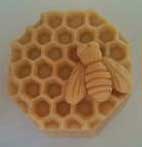
The honeycomb mould and the butterfly on daisies are a good size for gifts - around 80g. Add honey to melt and pour soap for the first, or let loose with the micas for a colour sensation in the second.
Our sheep have been flocking out the door. This is a great mould: a charming animal (it looks shorn after you've been using it for a while), good soap shape, and a nice hold-in-the-hand size at 125g.
If you like unusual things, the chrysanthemum will appeal. It looks great in bold colours, and getting it out of the mould is a breeze.
All of these single moulds are also available as mini kits - a wonderful gift for a crafty person.

Chelsea acting in Auckland:
Yet another shameless plug for Chelsea!
‘In the Next Room (or The Vibrator Play)’ had rave reviews in Dunedin in July, and Chelsea is now performing in 'N0ughty Girls' at The Basement in Auckland. It's a fun night out! Starts at 7 pm - final night is Saturday 25 August. http://www.iticket.co.nz/events/2012/jul/n0ughty-girls
Another emulsifier in stock:
Emulsifying wax NF has been used successfully in the personal care and pharmaceutical industries for many years. It's also called Polawax.
While it's not the most natural emulsifier, it is of vegetable origin, and is very reliable. Emulsifying wax NF can be used in both skin and hair care systems, producing emulsions with excellent texture and stability.
An update on preservatives
for creams and lotions
We no longer stock grapefruit seed extract, as according to the American Botanical Council, there is a possibility that much of the grapefruit seed extract available contains synthetic additives.
We want to be sure that you are using a safe and effective preservative in all your water-based formulations, and we believe there are better options than grapefruit seed extract.
Everyone who has made a water-based cream and left out the preservative is likely to have had an interesting experience: things grow in it! The bacteria, moulds and fungi that are present in all our homes appreciate a warm, damp environment. And some of the things that grow can be harmful to your health.
Sometimes a rich cream (with a low water content) containing essential oils will keep quite well as long as it is cool and in a dark jar, but preservation is not guaranteed. And undesirable things could be there in colonies too small to be visible to the naked eye. Just think about how often your finger goes in to the jar of your favourite cream…
We are constantly monitoring new developments in the preservative field and, at present, we believe that by far the most reliable preservative for the kinds of products you are making is Geogard 221. It is approved for use in certified organic skincare preparations. See our website for more details.
We have introduced a new product, Microcare DB, which has a similar formulation, Ecocert-approved ingredients and a lower price, and has performed well so far.
Name the triplets and win a mini-kit to make a sheep soap
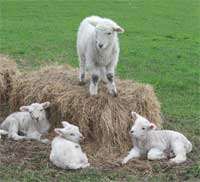 We have a mini-kit for a charming sheep soap for the winner of our name the lambs competition.
We have a mini-kit for a charming sheep soap for the winner of our name the lambs competition.
Our facebook followers have met the big lamb before – he is Roamer’s lamb, now named Romany.
The three little lambs are Latte’s triplets.

To enter, email your three names to jacqui@gonative.co.nz.
We will randomly draw five entries, and then choose our favourite from those five. The winner will be notified by email.
Entries close at midnight on Friday 31 August.
Love lemon? Try litsea cubeba (may chang) oil in the laundry...
"... I thought you might like to know another use for May Chang essential oil. I’ve been putting a teaspoon into my washing machine ‘fabric conditioner’ cup. It makes the whole load of washing (usually massage linen) smell wonderful!"
Jo Hogan
Bella Mama
www.bellamama.co.nz
Recipe substitution
Ever wanted to make something you see on the shop shelves?Here I (Elinor) will go through a recipe substitution using Trilogy Vital Moisturising Cream.
Ingredients should be listed in volume order meaning, in this case, that water accounts for the major part of the ingredients.
Here is the ingredients listing on the jar.
Remember the big clue: labelling rules require ingredients to be listed in volume order.
Now I look for an ingredient which is used at quite a specific percentage. Vitamin E is used at between 1% and 3%. Because this recipe has a preservative, we’ll use Vit E at 1%.
Everything below Vit E we’ll give half a gram to, 0.5g or 0.5%, because we are making 100g of cream.
So now, ingredients 11 to 17 add up to 4% or 4g.
Emulsifier is used at 6% or 6g.
So that’s 10%/10g we have used up: 4% + 6%.
Glycerin must be quite high, coming just under water. And water is often at least 40% of a recipe.
We’ll give water 50%/50g.
Glycerin 10%/10g.
So now we have accounted for 10%+50%+10% = 70%. 30% to go.
We have 6 oils: 3, 5, 6, 8, 9, 10, so let’s give them 5%/5g each.
Our tentative recipe is as follows:
Go Native Vital Moisturising Cream
Water phase
50g water
10g glycerin
Oil phase
6g emulsifier O
5g almond oil
5g evening primrose oil
5g jojoba oil
5g rosehip oil
5g marula oil
5g aloe vera leaf oil
Last phase
1g Vit E
0.5g carrot oil
0.5g chamomile essential oil
0.5g citrus aurantium amara (bitter orange) flower extract
0.5g rosemary leaf extract
0.5g Geogard 221
0.5g any essential oil
(A note about extracts: Use the ones above if you can find them.
Otherwise use any you fancy, or substitute with water.)
Method:
Heat water and glycerin to 65°C. This is the water phase.
At the same time, in a separate pot, heat to 65°C the emulsifier, almond oil, evening primrose oil, jojoba oil, rosehip oil, marula oil, aloe vera oil. This is the oil phase.
When both are at 65°C, combine and blend off and on until they start to thicken.
Now add the remaining ingredients (the last phase) and blend.
Pour into a pot.
I like the result! See how it goes for you - and remember to keep notes on exactly what you did.
Recipes
Two straightforward recipes this time, as well as a luxurious cream. The first recipe is a creamy shea butter bar. It's great when you are travelling - just smooth the bar over your skin.
And... another fabulous lip balm, with rich ingredients to protect your lips from winter winds and smooth away dryness.
The Elegant Cream is very simple too.
Shea Butter Bar (Makes a 200g bar)
Water phase
20g water
Oil phase
140g shea butter
32g Emulsifier O
Last phase
4g hydrolysed wheat protein
2g Geogard 221
few drops of essential oil
Method
Heat water and oil phases separately until they are 65°C.
Combine the two phases and blend.
When the mixture begins to thicken, add the last phase ingredients and blend.
Pour into 1 or 2 moulds and leave 24 hours to set.
To use, just rub the bar over your skin.
Vegan Lip Balm (Makes 200g)
40g candelilla wax
36g coconut oil
60g castor oil
60g almond oil
4g vitamin E
Melt wax and coconut oil on stovetop.
Add the rest of the ingredients, stir to blend and pour into pots.
Elegant Cream (Makes 200g)
Water phase
150g water
10g glycerin
teaspoon allantoin
Oil phase
12g conditioner pellets
12g jojoba oil
8g emulsifier O
4g shea butter
Last phase
4g hydrolysed wheat protein
2g Geogard 221
few drops essential oil
Method
Heat water and oil phases separately to 65°C.
Combine the two phases and blend.
When the mixture begins to thicken, add the last phase ingredients and blend again.
Pour into pots.
Weight and volume – what’s the difference?
Have you ever unpacked an order of oils or glycerin and wondered why a bottle isn’t full?
It’s a curious fact that if you weigh out 500g of different liquids, they may all have different volumes. You’ve no doubt experienced oils floating on water – the oil or fat rising to the top of a casserole; the oil sitting on top of the milk when you are making muffins. Oil is lighter than water.
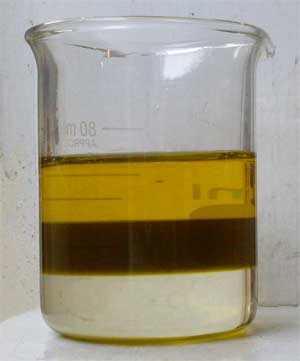
Probably the heaviest liquid that we stock is glycerin. It’s sold internationally by weight – so when you buy 500g of glycerin, there is some space left in the 500ml bottle.
A litre of water weighs 1 kilogram or 1000 grams.
However, if you measure out a litre of most oils, the weight will be around 900 grams – but oils do vary.
Here’s an example. We put three oils in a beaker (castor, avocado and jojoba). They quickly separated into precise layers! Castor, the most translucent and the heaviest, is on the bottom. The green avocado oil floats above it, and the golden jojoba oil, the lightest, sits on top of that.
We sell all our oils by volume, so if you’re buying a litre of castor oil, it will weigh 940 grams.
A litre of jojoba will weigh 860 grams.
Other oils are 900 grams.
Remember, the larger the volume you buy, the better the deal.
Navigating our website - helpful hints for the inexperienced
 Some of you have been wondering how to take things out of your shopping basket - it's all too easy to put them in!
Some of you have been wondering how to take things out of your shopping basket - it's all too easy to put them in!
Removing things is easy too. Put them in the trash! It's a symbol that's used all through the computer world: a little rubbish bin, or (in American English) a trash can.
The one on our checkout page is tiny, but it's there - just to the left of each item in your list.
Look at the example. Blue mica? No, not now. Click on the white trash can beside blue mica, and it's gone. Simple.
Last time we talked about the advantages of using the Login option from the bar across the top of the page.
Having an "account" with us is nothing to do with money - it simply means that the website stores your details so you never have to enter your address etc again. (Your details are safe with us - see here for our privacy policy.)

When you click on Login, you are asked for your username and password.
Your username is #Customer.Username#, and if you don't know your password you can request that it is sent to your email account.


And on the left, you can click on the name of the product to see background information about it.
What does it mean?
pH
In our next few newsletters, I’d like to look at some chemistry – the ideas behind the chemistry of skincare, and the chemistry of soapmaking.
pH These two letters look oddly back-to-front – but you see them often around skincare. It’s an international measure of how acidic or alkaline a solution is, based on how active the hydrogen ions are. (Remember those dangerous acids at school – hydrochloric acid has the formula HCl, where H stands for the potentially devastating hydrogen ions, and Cl is chlorine.)
A Danish chemist introduced the scale about a hundred years ago, and it has survived pretty much unchanged. The numbers seem a bit random to the non-mathematician - ‘neutral’ has a value of 7. Pure water at 25°C has a pH of 7.
Acids have a pH that’s less than 7 (really really strong hydrochloric acid has a pH of zero, while the hydrochloric acid in our stomach juices has a pH of 2-3).
Alkalis have a pH greater than 7. Substances used for cleaning are generally alkaline.
pH numbers seem odd because it’s an exponential scale (negative logarithmic, to be more precise) – think of those graphs of how the world’s population has dramatically increased over time, and you’ll get the idea: a number that’s far from 7 (bigger or smaller) indicates an extreme situation!
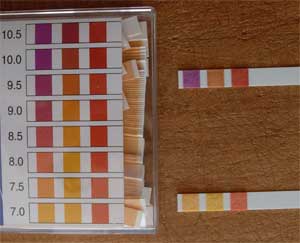
If you’ve ever been in charge of a swimming pool you will be familiar with measuring pH. Indicator strips make use of plant pigments that change colour when conditions become more acidic or alkaline.
I have two sets of indicator strips (measuring from 4.5 to 14) designed to be dipped in liquids. Each strip has three colour patches that can be matched against the standard on the pack.
Alkalis
Strong general-purpose cleaners for kitchens and bathrooms have quite a high pH. I just measured one straight from the bottle, and it’s around 12. My window cleaner, the last of a batch diluted from concentrate, is very slightly alkaline at 7.5. I thought it might be acidic, as a weak vinegar solution is an old-fashioned window cleaner… (ahh! Still around! Check out www.care2.com/greenliving/10030.html if you are interested in cleaning windows with vinegar.)
Acids
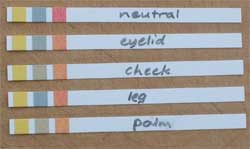 Our skin is slightly acidic. I’ve read that the skin around the eyes has a different pH from the rest of the face. Imagine me standing here with a damp indicator strip pressed against my skin – dampened in neutral pure water… I don’t know how skin pH is measured by skincare scientists, but no doubt a research chemist would be appalled at my technique! My dabbling suggests that the surface of my cheek and eyelid skin are within 0.5 of one another – the strips look identical, and indicate a pH of 5.5. Dry skin on my calf and the palm of my hand appears to be more acidic – though I have read that damaged skin loses its acidity and the microbial protection given by this. But one thing’s clear from my strips: my skin isn’t alkaline!
Our skin is slightly acidic. I’ve read that the skin around the eyes has a different pH from the rest of the face. Imagine me standing here with a damp indicator strip pressed against my skin – dampened in neutral pure water… I don’t know how skin pH is measured by skincare scientists, but no doubt a research chemist would be appalled at my technique! My dabbling suggests that the surface of my cheek and eyelid skin are within 0.5 of one another – the strips look identical, and indicate a pH of 5.5. Dry skin on my calf and the palm of my hand appears to be more acidic – though I have read that damaged skin loses its acidity and the microbial protection given by this. But one thing’s clear from my strips: my skin isn’t alkaline!
Now that you've read this far, I guarantee you'll notice pH all over the place!
Next time we will have a look at incredibly beautiful structures of carbon chemistry, and how the ‘fatty acids’ created by living systems differ from the simple mineral acids of school chemistry.
Selecting the right oil for the purpose...
Meet some more of our vegetable/carrier oils
In our last newsletter we introduced one way of talking about cosmetic oils, and how to use this information when combining oils for skincare.
Hope you've had a great time creating your own blends!
This time we'd like to introduce some more oils for you to experiment with. Remember that ideally you will use a mix of base, middle and top note oils in your creations.
There's more below about pomegranate oil, camellia oil and kiwi seed oil - then some suggestions for using these oils.
Pomegranate oil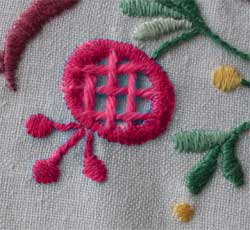
The pomegranate is an exquisitely coloured ancient fruit with glowing jewel-like seeds. It is so striking that it has been a symbol of abundance, fertility, birth and life for thousands of years. The pomegranate originated in the Middle East, spreading west into Europe and east as far as China. It features in numerous cultures and religions, including Greek myth, the Koran, and the Old Testament. I (Jacqui) love the depictions of pomegranates in medieval and baroque embroideries.
 Pomegranate oil has wonderful qualities for skincare. It has an unusual fatty acid profile, being one of the few plant sources of conjugated fatty acids. It contains almost 80% punicic acid, closely related to conjugated linoleic acid which is recognised as having powerful healing properties. Pomegranate oil repairs and revitalises tired skin, improving elasticity. Its anti-inflammatory properties make it a soothing addition to preparations for sensitive skin, eczema and psoriasis, and a useful addition to massage blends, as it can help to ease aching muscles.
Pomegranate oil has wonderful qualities for skincare. It has an unusual fatty acid profile, being one of the few plant sources of conjugated fatty acids. It contains almost 80% punicic acid, closely related to conjugated linoleic acid which is recognised as having powerful healing properties. Pomegranate oil repairs and revitalises tired skin, improving elasticity. Its anti-inflammatory properties make it a soothing addition to preparations for sensitive skin, eczema and psoriasis, and a useful addition to massage blends, as it can help to ease aching muscles.
Use pomegranate oil alone, or incorporate it in skincare recipes. Adding just a little to a formulation can make a difference.
Kiwi seed oil
This is one of New Zealand's gifts to the world!
Its composition is unusual: it contains about 60% alpha linolenic acid, an Omega 3 essential fatty acid which our bodies can’t synthesise.
This valuable oil enables the skin cell membranes to efficiently do their work of absorbing nutrients and eliminating waste, so it helps with tissue repair, and keeps the skin soft and pliable. It’s a great anti-ageing oil, and ideal for sensitive skin.
Because it’s quickly absorbed, it’s a very good face oil. Use it as an ingredient in facial serums, eye creams (it is a soft oil), and lip balms. Its high alpha linolenic acid content means it’s also great in hair products – for example, you could substitute kiwi seed oil for say 30 grams of the macadamia oil in our Amazing Hair Mask recipe.
Our kiwi seed oil is produced in New Zealand by CO2 extraction, a process which gives an extremely pure oil.
Camellia oil
 Treasured in China and Japan for thousands of years, camellia oil is rapidly becoming recognised in the western world and is an ingredient in many high-quality preparations. It is wonderful for all skin types, and is mild and gentle on easily inflamed skin.
Treasured in China and Japan for thousands of years, camellia oil is rapidly becoming recognised in the western world and is an ingredient in many high-quality preparations. It is wonderful for all skin types, and is mild and gentle on easily inflamed skin.
It rapidly penetrates to the deepest layers of the skin, making it invaluable in serums. Added to formulations for the face, it helps protect the skin from environmental pollutants.
Camellia oil is about 85% oleic acid, an excellent emollient which helps retain skin moisture. The oil has been shown to be exceptionally high in antioxidants, and also contains a number of vitamins and minerals.
The camellia tree has been cultivated for a very long time, and the oil is obtained from Camellia oleifera as well as Camellia sinensis or Camellia japonica.
Use camellia oil on its own on skin or hair, or add 10-15% to your formulations. You will be delighted with the results.
Here are two simple recipes adapted from our website that you can modify by including the oils we’ve been talking about.
Baby Balm
15g beeswax
80g organic vegetable oil of your choice (see suggestions below)
5g essential oil
Gently melt the beeswax, add the oil and blend. Add the essential oil and blend again. Pour into pots and let set. Sunflower Cream
Sunflower Cream
400g water
75g sunflower oil
30g Emulsifier HE20
12g Geogard 221
Put the water, sunflower oil and HE20 in a pot and heat until the HE20 is melted.
Blend off and on until thick. Add Geogard 221. Blend.
The days are lengthening, the sun is warming up, and soon the miserable months will be behind us.
Time to think about preparing for summer - maybe feeding your skin with a blend of organic oils, or creating a cream or a scrub to enliven the limbs. Enjoy the sunshine!
Kind regards
Elinor, Chelsea, & Jacqui

- What's new: New moulds; Chelsea's play in Auckland; Another emulsifier in stock; Preservatives: out with grapefruit seed extract, in with a new product
- Competition: Name the lambs and win a sheep soap kit
- Substitution: Make your own version of some local products
- Recipes: shea butter bar, vegan lip balm, elegant cream
- Weight and volume: what's the difference?
- For the inexperienced: Emptying the shopping basket
- What does it mean? pH
- Selecting the right oil for the purpose - some interesting oils to experiment with
What's new...
New moulds:
 New moulds that have arrived since our last newsletter have something for everyone. My favourite is the three-cavity mould with a heart, a round and an oval - it's so difficult to find really nice basic shapes, and these make elegant small soaps.
New moulds that have arrived since our last newsletter have something for everyone. My favourite is the three-cavity mould with a heart, a round and an oval - it's so difficult to find really nice basic shapes, and these make elegant small soaps.
The honeycomb mould and the butterfly on daisies are a good size for gifts - around 80g. Add honey to melt and pour soap for the first, or let loose with the micas for a colour sensation in the second.
Our sheep have been flocking out the door. This is a great mould: a charming animal (it looks shorn after you've been using it for a while), good soap shape, and a nice hold-in-the-hand size at 125g.
If you like unusual things, the chrysanthemum will appeal. It looks great in bold colours, and getting it out of the mould is a breeze.
All of these single moulds are also available as mini kits - a wonderful gift for a crafty person.

Chelsea acting in Auckland:
Yet another shameless plug for Chelsea!
‘In the Next Room (or The Vibrator Play)’ had rave reviews in Dunedin in July, and Chelsea is now performing in 'N0ughty Girls' at The Basement in Auckland. It's a fun night out! Starts at 7 pm - final night is Saturday 25 August. http://www.iticket.co.nz/events/2012/jul/n0ughty-girls
Another emulsifier in stock:
Emulsifying wax NF has been used successfully in the personal care and pharmaceutical industries for many years. It's also called Polawax.
While it's not the most natural emulsifier, it is of vegetable origin, and is very reliable. Emulsifying wax NF can be used in both skin and hair care systems, producing emulsions with excellent texture and stability.
An update on preservatives

for creams and lotions
We no longer stock grapefruit seed extract, as according to the American Botanical Council, there is a possibility that much of the grapefruit seed extract available contains synthetic additives.
We want to be sure that you are using a safe and effective preservative in all your water-based formulations, and we believe there are better options than grapefruit seed extract.
Everyone who has made a water-based cream and left out the preservative is likely to have had an interesting experience: things grow in it! The bacteria, moulds and fungi that are present in all our homes appreciate a warm, damp environment. And some of the things that grow can be harmful to your health.
Sometimes a rich cream (with a low water content) containing essential oils will keep quite well as long as it is cool and in a dark jar, but preservation is not guaranteed. And undesirable things could be there in colonies too small to be visible to the naked eye. Just think about how often your finger goes in to the jar of your favourite cream…
We are constantly monitoring new developments in the preservative field and, at present, we believe that by far the most reliable preservative for the kinds of products you are making is Geogard 221. It is approved for use in certified organic skincare preparations. See our website for more details.
We have introduced a new product, Microcare DB, which has a similar formulation, Ecocert-approved ingredients and a lower price, and has performed well so far.
Name the triplets and win a mini-kit to make a sheep soap
 We have a mini-kit for a charming sheep soap for the winner of our name the lambs competition.
We have a mini-kit for a charming sheep soap for the winner of our name the lambs competition.Our facebook followers have met the big lamb before – he is Roamer’s lamb, now named Romany.
The three little lambs are Latte’s triplets.

To enter, email your three names to jacqui@gonative.co.nz.
We will randomly draw five entries, and then choose our favourite from those five. The winner will be notified by email.
Entries close at midnight on Friday 31 August.
Love lemon? Try litsea cubeba (may chang) oil in the laundry...
"... I thought you might like to know another use for May Chang essential oil. I’ve been putting a teaspoon into my washing machine ‘fabric conditioner’ cup. It makes the whole load of washing (usually massage linen) smell wonderful!"
Jo Hogan
Bella Mama
www.bellamama.co.nz
Recipe substitution
Ever wanted to make something you see on the shop shelves?Here I (Elinor) will go through a recipe substitution using Trilogy Vital Moisturising Cream.
Ingredients should be listed in volume order meaning, in this case, that water accounts for the major part of the ingredients.
Here is the ingredients listing on the jar.
| 1. Aqua (purified spring water) | |
| 2. Glycerin | |
| 3. Prunus amygdalus dulcis (sweet almond) oil | |
| 4. Glyceryl stearate, emulsifier | |
| 5. Oenothera biennis (evening primrose) oil | |
| 6. Simmondsia chinensis (jojoba) oil | |
| 7. Cetearyl wheat straw glycosides & cetearyl alcohol emulsifier | |
| 8. Rosa canina (rosehip) oil | |
| 9. Sclerocarya birrea (marula seed) oil | |
| 10. Aloe barbadensis (aloe vera) leaf oil | |
| 11. Tocopheryl acetate, Vit E | |
| 12. Daucus carota sativa (carrot) oil | |
| 13. Ormenis multicaulis (chamomile flower) oil, essential oil | |
| 14. Citrus aurantium amara (bitter orange) flower extract | |
| 15. Rosmarinus Officinalis (rosemary) leaf extract | |
| 16. Phenoxyethanol, ethylhexylglycerin, preservative | |
| 17. Parfum, citral, geraniol, citronellol, limonene, linalool, components of natural essential oils |
Remember the big clue: labelling rules require ingredients to be listed in volume order.
Now I look for an ingredient which is used at quite a specific percentage. Vitamin E is used at between 1% and 3%. Because this recipe has a preservative, we’ll use Vit E at 1%.
Everything below Vit E we’ll give half a gram to, 0.5g or 0.5%, because we are making 100g of cream.
So now, ingredients 11 to 17 add up to 4% or 4g.
Emulsifier is used at 6% or 6g.
So that’s 10%/10g we have used up: 4% + 6%.
Glycerin must be quite high, coming just under water. And water is often at least 40% of a recipe.
We’ll give water 50%/50g.
Glycerin 10%/10g.
So now we have accounted for 10%+50%+10% = 70%. 30% to go.
We have 6 oils: 3, 5, 6, 8, 9, 10, so let’s give them 5%/5g each.
Our tentative recipe is as follows:
Go Native Vital Moisturising Cream
Water phase
50g water
10g glycerin
Oil phase
6g emulsifier O
5g almond oil
5g evening primrose oil
5g jojoba oil
5g rosehip oil
5g marula oil
5g aloe vera leaf oil
Last phase
1g Vit E
0.5g carrot oil
0.5g chamomile essential oil
0.5g citrus aurantium amara (bitter orange) flower extract
0.5g rosemary leaf extract
0.5g Geogard 221
0.5g any essential oil
(A note about extracts: Use the ones above if you can find them.

Otherwise use any you fancy, or substitute with water.)
Method:
Heat water and glycerin to 65°C. This is the water phase.
At the same time, in a separate pot, heat to 65°C the emulsifier, almond oil, evening primrose oil, jojoba oil, rosehip oil, marula oil, aloe vera oil. This is the oil phase.
When both are at 65°C, combine and blend off and on until they start to thicken.
Now add the remaining ingredients (the last phase) and blend.
Pour into a pot.
I like the result! See how it goes for you - and remember to keep notes on exactly what you did.
Recipes
Two straightforward recipes this time, as well as a luxurious cream. The first recipe is a creamy shea butter bar. It's great when you are travelling - just smooth the bar over your skin.
And... another fabulous lip balm, with rich ingredients to protect your lips from winter winds and smooth away dryness.
The Elegant Cream is very simple too.
Shea Butter Bar (Makes a 200g bar)

Water phase
20g water
Oil phase
140g shea butter
32g Emulsifier O
Last phase
4g hydrolysed wheat protein
2g Geogard 221
few drops of essential oil
Method
Heat water and oil phases separately until they are 65°C.
Combine the two phases and blend.
When the mixture begins to thicken, add the last phase ingredients and blend.
Pour into 1 or 2 moulds and leave 24 hours to set.
To use, just rub the bar over your skin.
Vegan Lip Balm (Makes 200g)
40g candelilla wax
36g coconut oil
60g castor oil
60g almond oil
4g vitamin E
Melt wax and coconut oil on stovetop.
Add the rest of the ingredients, stir to blend and pour into pots.
Elegant Cream (Makes 200g)
Water phase
150g water
10g glycerin
teaspoon allantoin
Oil phase
12g conditioner pellets
12g jojoba oil
8g emulsifier O
4g shea butter
Last phase
4g hydrolysed wheat protein
2g Geogard 221
few drops essential oil
Method
Heat water and oil phases separately to 65°C.
Combine the two phases and blend.
When the mixture begins to thicken, add the last phase ingredients and blend again.
Pour into pots.
Weight and volume – what’s the difference?
Have you ever unpacked an order of oils or glycerin and wondered why a bottle isn’t full?
It’s a curious fact that if you weigh out 500g of different liquids, they may all have different volumes. You’ve no doubt experienced oils floating on water – the oil or fat rising to the top of a casserole; the oil sitting on top of the milk when you are making muffins. Oil is lighter than water.

Probably the heaviest liquid that we stock is glycerin. It’s sold internationally by weight – so when you buy 500g of glycerin, there is some space left in the 500ml bottle.
A litre of water weighs 1 kilogram or 1000 grams.
However, if you measure out a litre of most oils, the weight will be around 900 grams – but oils do vary.
Here’s an example. We put three oils in a beaker (castor, avocado and jojoba). They quickly separated into precise layers! Castor, the most translucent and the heaviest, is on the bottom. The green avocado oil floats above it, and the golden jojoba oil, the lightest, sits on top of that.
We sell all our oils by volume, so if you’re buying a litre of castor oil, it will weigh 940 grams.
A litre of jojoba will weigh 860 grams.
Other oils are 900 grams.
Remember, the larger the volume you buy, the better the deal.
Navigating our website - helpful hints for the inexperienced
 Some of you have been wondering how to take things out of your shopping basket - it's all too easy to put them in!
Some of you have been wondering how to take things out of your shopping basket - it's all too easy to put them in!Removing things is easy too. Put them in the trash! It's a symbol that's used all through the computer world: a little rubbish bin, or (in American English) a trash can.
The one on our checkout page is tiny, but it's there - just to the left of each item in your list.
Look at the example. Blue mica? No, not now. Click on the white trash can beside blue mica, and it's gone. Simple.
Last time we talked about the advantages of using the Login option from the bar across the top of the page.
Having an "account" with us is nothing to do with money - it simply means that the website stores your details so you never have to enter your address etc again. (Your details are safe with us - see here for our privacy policy.)

When you click on Login, you are asked for your username and password.
Your username is #Customer.Username#, and if you don't know your password you can request that it is sent to your email account.

And from our last newsletter, for new people:
Want to order an amount other than the one shown?
Just click on the white bar to see the other sizes available for this product.
Want to order an amount other than the one shown?
Just click on the white bar to see the other sizes available for this product.

And on the left, you can click on the name of the product to see background information about it.
What does it mean?
pH
In our next few newsletters, I’d like to look at some chemistry – the ideas behind the chemistry of skincare, and the chemistry of soapmaking.
pH These two letters look oddly back-to-front – but you see them often around skincare. It’s an international measure of how acidic or alkaline a solution is, based on how active the hydrogen ions are. (Remember those dangerous acids at school – hydrochloric acid has the formula HCl, where H stands for the potentially devastating hydrogen ions, and Cl is chlorine.)
A Danish chemist introduced the scale about a hundred years ago, and it has survived pretty much unchanged. The numbers seem a bit random to the non-mathematician - ‘neutral’ has a value of 7. Pure water at 25°C has a pH of 7.
Acids have a pH that’s less than 7 (really really strong hydrochloric acid has a pH of zero, while the hydrochloric acid in our stomach juices has a pH of 2-3).
Alkalis have a pH greater than 7. Substances used for cleaning are generally alkaline.
pH numbers seem odd because it’s an exponential scale (negative logarithmic, to be more precise) – think of those graphs of how the world’s population has dramatically increased over time, and you’ll get the idea: a number that’s far from 7 (bigger or smaller) indicates an extreme situation!

If you’ve ever been in charge of a swimming pool you will be familiar with measuring pH. Indicator strips make use of plant pigments that change colour when conditions become more acidic or alkaline.
I have two sets of indicator strips (measuring from 4.5 to 14) designed to be dipped in liquids. Each strip has three colour patches that can be matched against the standard on the pack.
Alkalis
Strong general-purpose cleaners for kitchens and bathrooms have quite a high pH. I just measured one straight from the bottle, and it’s around 12. My window cleaner, the last of a batch diluted from concentrate, is very slightly alkaline at 7.5. I thought it might be acidic, as a weak vinegar solution is an old-fashioned window cleaner… (ahh! Still around! Check out www.care2.com/greenliving/10030.html if you are interested in cleaning windows with vinegar.)
Acids
 Our skin is slightly acidic. I’ve read that the skin around the eyes has a different pH from the rest of the face. Imagine me standing here with a damp indicator strip pressed against my skin – dampened in neutral pure water… I don’t know how skin pH is measured by skincare scientists, but no doubt a research chemist would be appalled at my technique! My dabbling suggests that the surface of my cheek and eyelid skin are within 0.5 of one another – the strips look identical, and indicate a pH of 5.5. Dry skin on my calf and the palm of my hand appears to be more acidic – though I have read that damaged skin loses its acidity and the microbial protection given by this. But one thing’s clear from my strips: my skin isn’t alkaline!
Our skin is slightly acidic. I’ve read that the skin around the eyes has a different pH from the rest of the face. Imagine me standing here with a damp indicator strip pressed against my skin – dampened in neutral pure water… I don’t know how skin pH is measured by skincare scientists, but no doubt a research chemist would be appalled at my technique! My dabbling suggests that the surface of my cheek and eyelid skin are within 0.5 of one another – the strips look identical, and indicate a pH of 5.5. Dry skin on my calf and the palm of my hand appears to be more acidic – though I have read that damaged skin loses its acidity and the microbial protection given by this. But one thing’s clear from my strips: my skin isn’t alkaline!Now that you've read this far, I guarantee you'll notice pH all over the place!
Next time we will have a look at incredibly beautiful structures of carbon chemistry, and how the ‘fatty acids’ created by living systems differ from the simple mineral acids of school chemistry.
Selecting the right oil for the purpose...
Meet some more of our vegetable/carrier oils
In our last newsletter we introduced one way of talking about cosmetic oils, and how to use this information when combining oils for skincare.
Hope you've had a great time creating your own blends!
This time we'd like to introduce some more oils for you to experiment with. Remember that ideally you will use a mix of base, middle and top note oils in your creations.
- Top-note oils are absorbed within minutes of being applied to the skin.
- Middle-note oils take longer to be absorbed.
- Base note oils stay on the skin for quite a long time.
| viscosity | sticky? | massage | note? | |
| Pomegranate | thickish | sticky | short | base |
| Sesame | slightly thick | long | middle | |
| Camellia | very smooth | medium | middle | |
| Sunflower | thin | longish | top | |
| Kiwi seed | thin | smooth | top | |
| Evening primrose | thinnish | short | top | |
| Grape seed | thinnish | slightly sticky | medium | top |
There's more below about pomegranate oil, camellia oil and kiwi seed oil - then some suggestions for using these oils.
Pomegranate oil

The pomegranate is an exquisitely coloured ancient fruit with glowing jewel-like seeds. It is so striking that it has been a symbol of abundance, fertility, birth and life for thousands of years. The pomegranate originated in the Middle East, spreading west into Europe and east as far as China. It features in numerous cultures and religions, including Greek myth, the Koran, and the Old Testament. I (Jacqui) love the depictions of pomegranates in medieval and baroque embroideries.
 Pomegranate oil has wonderful qualities for skincare. It has an unusual fatty acid profile, being one of the few plant sources of conjugated fatty acids. It contains almost 80% punicic acid, closely related to conjugated linoleic acid which is recognised as having powerful healing properties. Pomegranate oil repairs and revitalises tired skin, improving elasticity. Its anti-inflammatory properties make it a soothing addition to preparations for sensitive skin, eczema and psoriasis, and a useful addition to massage blends, as it can help to ease aching muscles.
Pomegranate oil has wonderful qualities for skincare. It has an unusual fatty acid profile, being one of the few plant sources of conjugated fatty acids. It contains almost 80% punicic acid, closely related to conjugated linoleic acid which is recognised as having powerful healing properties. Pomegranate oil repairs and revitalises tired skin, improving elasticity. Its anti-inflammatory properties make it a soothing addition to preparations for sensitive skin, eczema and psoriasis, and a useful addition to massage blends, as it can help to ease aching muscles.Use pomegranate oil alone, or incorporate it in skincare recipes. Adding just a little to a formulation can make a difference.
Kiwi seed oil

This is one of New Zealand's gifts to the world!
Its composition is unusual: it contains about 60% alpha linolenic acid, an Omega 3 essential fatty acid which our bodies can’t synthesise.
This valuable oil enables the skin cell membranes to efficiently do their work of absorbing nutrients and eliminating waste, so it helps with tissue repair, and keeps the skin soft and pliable. It’s a great anti-ageing oil, and ideal for sensitive skin.
Because it’s quickly absorbed, it’s a very good face oil. Use it as an ingredient in facial serums, eye creams (it is a soft oil), and lip balms. Its high alpha linolenic acid content means it’s also great in hair products – for example, you could substitute kiwi seed oil for say 30 grams of the macadamia oil in our Amazing Hair Mask recipe.
Our kiwi seed oil is produced in New Zealand by CO2 extraction, a process which gives an extremely pure oil.
Camellia oil
 Treasured in China and Japan for thousands of years, camellia oil is rapidly becoming recognised in the western world and is an ingredient in many high-quality preparations. It is wonderful for all skin types, and is mild and gentle on easily inflamed skin.
Treasured in China and Japan for thousands of years, camellia oil is rapidly becoming recognised in the western world and is an ingredient in many high-quality preparations. It is wonderful for all skin types, and is mild and gentle on easily inflamed skin.It rapidly penetrates to the deepest layers of the skin, making it invaluable in serums. Added to formulations for the face, it helps protect the skin from environmental pollutants.
Camellia oil is about 85% oleic acid, an excellent emollient which helps retain skin moisture. The oil has been shown to be exceptionally high in antioxidants, and also contains a number of vitamins and minerals.
The camellia tree has been cultivated for a very long time, and the oil is obtained from Camellia oleifera as well as Camellia sinensis or Camellia japonica.
Use camellia oil on its own on skin or hair, or add 10-15% to your formulations. You will be delighted with the results.
Here are two simple recipes adapted from our website that you can modify by including the oils we’ve been talking about.
Baby Balm
15g beeswax
80g organic vegetable oil of your choice (see suggestions below)
5g essential oil
Gently melt the beeswax, add the oil and blend. Add the essential oil and blend again. Pour into pots and let set.
- Sunflower, grape seed, sweet almond and rosehip are good base oils for this recipe.
- You could make up the 80g of oil by using 60g of one of these, and 10g of two other oils, such as kiwi seed and camellia.
- Add more beeswax for a firmer balm, more oil for a softer one.
 Sunflower Cream
Sunflower Cream400g water
75g sunflower oil
30g Emulsifier HE20
12g Geogard 221
Put the water, sunflower oil and HE20 in a pot and heat until the HE20 is melted.
Blend off and on until thick. Add Geogard 221. Blend.
- As with the baby balm, you can use a mixture of oils to make up your 75g of oil.
- For example, use 50g of sunflower oil, 15g of a ‘top note’ oil, and 10g of a ‘base note’ oil.

The days are lengthening, the sun is warming up, and soon the miserable months will be behind us.
Time to think about preparing for summer - maybe feeding your skin with a blend of organic oils, or creating a cream or a scrub to enliven the limbs. Enjoy the sunshine!
Kind regards
Elinor, Chelsea, & Jacqui
